Abstract
The increasing global demand for clean energy highlights hydrogen as a strategic energy carrier due to its high energy density and carbon-free utilization. Currently, steam methane reforming (SMR) is the most widely applied method for hydrogen production; however, its high CO2 emissions undermine the environmental benefits of hydrogen. Blue hydrogen production integrates carbon capture and storage (CCS) technologies to overcome this drawback in the SMR process, significantly reducing greenhouse gas emissions. This study integrated a MATLAB-R2025b-based plug flow reactor (PFR) model for SMR kinetics with an Aspen HYSYS-based CCS system. The effects of reformer temperature (600–1000 °C) and steam-to-carbon (S/C) ratio (1–5) on hydrogen yield and CO2 emission intensity were investigated. Results show that hydrogen production increases with temperature, reaching maximum conversion at 850–1000 °C, while the optimum performance is achieved at S/C ratios of 2.5–3.0, balancing high hydrogen yield and minimized methane slip. Conventional SMR generates 9–12 kgCO2/kgH2 emissions, whereas SMR + CCS reduces this to 2–3 kgCO2/kgH2, achieving more than 75% reduction. The findings demonstrate that SMR + CCS integration effectively mitigates emissions and provides a sustainable bridging technology for blue hydrogen production, supporting the transition toward low-carbon energy systems.
1. Introduction
Population growth, industrialization, and technological advancement have led to a continuous increase in global energy demand. Most of this demand is met by fossil fuels such as coal, oil, and natural gas. However, the combustion of these fuels generates large amounts of greenhouse gases, particularly carbon dioxide (CO2), which is considered one of the primary drivers of climate change [].
In recent years, international agreements and decarbonization policies have accelerated the transition toward renewable and low-carbon energy systems. Although solar, wind, biomass, and geothermal energy sources are increasingly integrated into the global energy mix, their intermittent and variable nature poses challenges for energy supply security []. Hydrogen has emerged as a strategic energy carrier due to its high energy density, broad applicability across industrial sectors, and carbon-free combustion characteristics [].
Hydrogen combustion produces only water vapor, making it an environmentally friendly fuel []. These attributes allow hydrogen to be utilized in diverse applications, including transportation, energy storage, power generation, steel manufacturing, and the chemical industry []. Therefore, hydrogen is not merely a fuel but also a strategic energy vector that links various sectors of the energy system [].
Because hydrogen does not occur naturally in its molecular form, it must be produced through various chemical processes []. Color codes categorize several production routes based on their carbon footprint []. Gray, blue, and green hydrogen are the most widely discussed among these. Gray hydrogen, the most common method, is produced via steam methane reforming (SMR) of natural gas or coal gasification [,]. However, this process emits 9–12 kg of CO2 per kilogram of hydrogen produced, significantly undermining the environmental advantages of hydrogen [].
Low-carbon production routes must be adopted to enable hydrogen’s sustainable role in the energy transition. Blue hydrogen is a leading alternative, achieved by incorporating carbon capture, utilization, and storage (CCUS) technologies into the reforming process [,]. Blue hydrogen substantially reduces lifecycle emissions compared with gray hydrogen by capturing approximately 70–90% of the CO2 generated during SMR or autothermal reforming (ATR) []. Thus, integrating carbon capture and storage (CCS) into conventional SMR processes significantly mitigates greenhouse gas emissions. While blue hydrogen provides an immediate and scalable pathway using existing natural gas infrastructure, green hydrogen, produced via renewable-powered electrolysis, remains the ultimate long-term solution for achieving a fully carbon-neutral hydrogen economy.
Carbon capture technologies can be implemented through various methods. CO2 can be permanently stored using geological sequestration, such as injection into depleted oil and gas reservoirs or deep saline aquifers [,,]. Alternatively, it can be utilized as a feedstock in the chemical industry to produce value-added compounds through carbon capture and utilization (CCU) processes []. By integrating these technologies, blue hydrogen is an essential bridge toward a low-carbon energy future [].
Given its potential to deliver decarbonized energy at scale, research on blue hydrogen has expanded rapidly in recent years. Pistida [] compared different hydrogen production pathways via life cycle assessment (LCA) and demonstrated that integrating CCS substantially reduces the environmental impacts of hydrogen. Diab et al. [] reported that CCS technologies can reduce CO2-equivalent emissions by 50–85% in SMR-based hydrogen systems. Curcio [] showed that, although CCS integration increases production costs compared with gray hydrogen, the resulting blue hydrogen becomes cost-competitive with green hydrogen.
Massarweh et al. [] reviewed the fundamental processes of blue hydrogen production and highlighted the critical role of CCS technologies in lowering CO2 emissions in SMR-based systems. Oni et al. [] conducted a comparative techno-economic analysis of blue hydrogen production via SMR, ATR, and natural gas separation, emphasizing each configuration’s cost and lifecycle trade-offs. Khan et al. [] developed a geographically and technologically integrated techno-economic model for blue hydrogen, assessing the feasibility of CCUS deployment. Similarly, Katebah et al. [] demonstrated that integrating CO2 capture into SMR processes can achieve up to 90% emission reduction with only a 13% increase in production cost.
Although numerous studies have analyzed SMR and CCS separately, few have quantitatively linked kinetic, thermodynamic, and environmental parameters within a unified modeling framework. This study addresses that gap by integrating a MATLAB-based plug flow reactor (PFR) model for SMR kinetics with an Aspen HYSYS-based CCS system to evaluate the effects of the reformer temperature and steam-to-carbon (S/C) ratio on hydrogen yield and CO2 emission intensity. Unlike previous equilibrium-based or isolated process studies, the present work directly couples the reactor kinetics with CO2 capture, enabling a fully integrated assessment of process performance and mitigation efficiency. This coupled kinetic–thermodynamic–environmental analysis provides valuable insights for optimizing blue hydrogen production efficiency while minimizing carbon footprint.
2. Methodology
2.1. Process Definition
The SMR method is currently the most widely used method for hydrogen production. However, this method causes a high carbon footprint due to its dependence on fossil fuels. Therefore, using renewable sources or eliminating carbon dioxide emissions is necessary. For this reason, blue hydrogen is produced using a CCS system integrated into SMR reactors to optimize SMR processes and reduce their environmental impact []. This study presents a combination of SMR and CCS systems. As a result, CO2 emissions generated by the SMR system are eliminated. Figure 1 shows the SMR + CCS system used in the study.
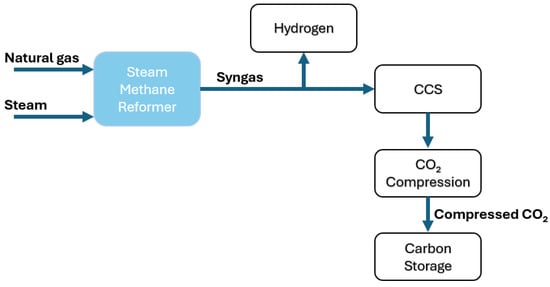
Figure 1.
System definition of SMR + CCS.
2.2. SMR Reactor
The SMR reactor was modeled as an isothermal plug flow reactor (PFR) operating under steady-state, gas-phase conditions. The methane and steam feed mixture enters from one end of the catalyst bed and flows axially, with concentration and temperature varying along the reactor length. This configuration assumes no radial mixing and perfect plug flow behavior, consistent with the typical design and modeling assumptions for industrial SMR tubular reactors. The advantages of this type of reactor include no need for mixing, low energy consumption, simple structure, and good stability []. The reactor model was modeled using MATLAB as an isothermal, differential PFR and 1-B. The species vary throughout the reactor depending on environmental conditions such as temperature and pressure. A catalyst is used throughout the system and is defined by pressure drop and porous medium Ergun equations [,]. The study modeled SMR reactions to CH4, H2O, CO, CO2 and H2. Two reactions are required for hydrogen production in SMR reactors, one of which is the Water Gas Shift reaction. Equations (1) and (3) represent SMR reactions, while Equation (2) represents the WGS reaction [,].
This three-tiered reaction structure used in SMR reactors is standard in ‘final’ models based on Langmuir–Hinshelwood–Hougen–Watson kinetics (LH-HW) for SMR + WGS on Ni catalyst [,]. Different rate equations are derived by applying the LH–HW approach to the kinetic mechanism of the SMR reactor. Freundlich’s non-ideal adsorption concept is used to adjust the forces in the rate equations of steam and hydrogen, which are the main adsorbate components in SMR processes, taking into account the hydrogen production performance of the catalyst surface [,]. The set of rate equations used in the study is given between Equations (4) and (7).
where Kp1, Kp2, and Kp3 are the equilibrium constants, and P is the partial pressure. In this structure, only CO, H2, and H2O adsorption are retained in the denominator; the literature shows that this minimal denominator best matches the data []. In chemical processes, the Arrhenius equation defines how each type changes depending on the temperature and catalyst structure used []. The Arrhenius equation and the Van’t Hoff equation are given in Equation (8) and Equation (9), respectively [].
where reaction rate, is the frequency, is the activation rate, formation enthalpy and R is the universal gas constant. For the Arrhenius equation and the Van’t Hoff equation, the constants used in the SMR reactor are given in Table 1.

Table 1.
Constants of the Arrhenius equation and the Van’t Hoff equation.
In addition, the Gibbs free energy minimization and equilibrium constants used in the reactions are calculated using Equations (10) and (11) and are obtained from the NIST chemistry web book database [].
where Gibbs free energy and change in entropy. Table 2 shows the change in enthalpy and entropy for equilibrium constants.

Table 2.
Thermodynamics parameters of equilibrium constants.
The kinetic parameters, including rate constants and adsorption coefficients, were adopted from the well-established Langmuir–Hinshelwood–Hougen–Watson (LH–HW) model developed by Xu and Froment (1989) [] for Ni-based catalysts. This model has been extensively validated in subsequent works [,] and provides reliable performance across the 600–1000 °C operating range. The present study applied these parameters without recalibration, and model predictions were benchmarked against reported data, showing deviations within ±5%, thereby confirming the validity of the adopted kinetics for the SMR reactor model.
Figure 2 shows the numerical solution flow chart of the SMR system. The algorithm begins with the definition of boundary conditions, reformer temperature (T), reformer pressure (P) and steam-methane ratio (S/C). The adsorption coefficients and equilibrium constants required for LH-HW-based reaction rates are calculated from thermodynamic relationships. These quantities are transferred to the ODE-based PFR model, and the solution is obtained across the catalyst mass. When convergence criteria are met, the results are reported as H2 production rate and CO2 emissions; if convergence is not achieved, the parameters/initial values are updated and the solution is repeated. The arrows represent the data flow and computational sequence within the simulation process. Boundary conditions and reaction parameters are transferred to the numerical solver, which iteratively computes the governing equations until convergence is achieved. Upon convergence, the model outputs the main performance indicators, including hydrogen production rate and CO2 emissions.
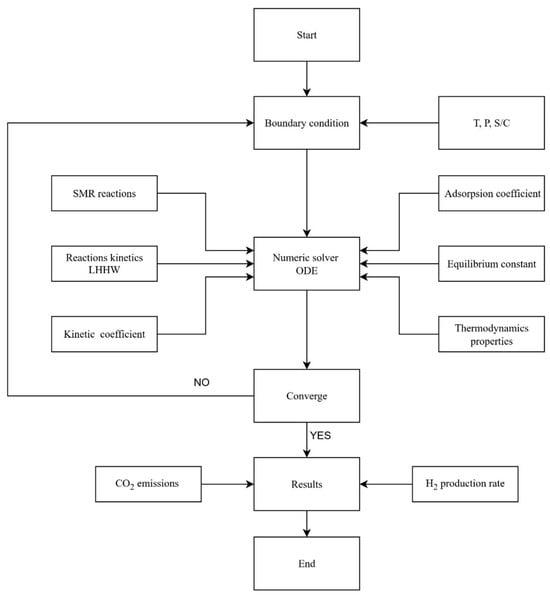
Figure 2.
SMR numerical solution flow chart.
Calculating CO2 emissions from fuel used to heat the reactor is an essential parameter for the entire system. The CO2 emissions generated vary depending on the heat load of the system and the amount of CH4 consumed. The reactor heat load is expressed by Equation (12).
where is the heat loss of the system, is the feed heat to the reactor and is the loss heat from the reactor and it has been assumed to be 5%. The feed heat to the reactor can be determined as Equation (13) [].
The equation expresses the temperature required to heat the CH4 and H2O components at the reformer inlet to temperature T. The and enthalpy functions for each type can be obtained from the NIST Chemistry WebBook []. The thermal power efficiency and fuel energy required to heat the reactor are obtained from the relationship between the reformer furnace efficiency and fuel power. Equation (14) expresses the fuel energy needed to heat the reformer to the desired temperature.
Thermal efficiency in the range of 85–90% is also seen in large-scale SMRs and modern applications []. The CO2 emissions to heat the reactor can be calculated as Equation (15)
where is the natural gas emission factor, which is taken as 2.75 [].
2.3. Carbon Capture and Storage System
A CCS system has been integrated to reduce CO2 emissions from the SMR model analyzed in the previous section. CO2 capture helps reduce greenhouse gas emissions associated with hydrogen production and is an important technology that supports global goals to reduce carbon footprints []. Carbon capture is a chemical process that uses absorbent and solvent components, dependent on mass transfer, to capture CO2. This study used commercially available 30% by weight monoethanolamine (MEA) solvent to remove CO2 from flue gas in the blue H2 value chain []. It was modeled using the Aspen HYSYS model as shown in Figure 3. The absorber inlet consists of SMR outlet components. The red lines indicate the flow of exhaust gas and steam, while the turquoise lines represent the circulation of the MEA solution between the absorber and stripper columns. The system includes key components such as pumps, heat exchangers (HX), mixer, reboiler, and the stripper, enabling CO2 separation and regeneration of the solvent.
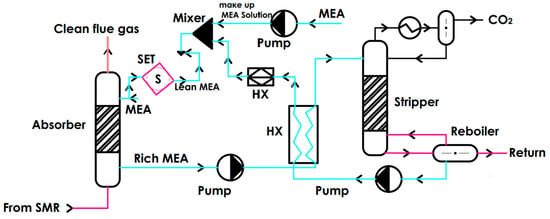
Figure 3.
CCS System modeling for the SMR model.
The carbon capture process used in the model operates under appropriate temperature and pressure conditions. The method recommended for the CCS system integrated into the SMR system was simulated using Aspen HYSYS V12. This commercial simulation program applies the Peng-Robinson state equation to calculate thermodynamic properties, providing high accuracy across various temperatures and pressures [].
The CCS subsystem was modeled in Aspen HYSYS V12 using the Peng–Robinson equation of state for vapor–liquid equilibrium and the Electrolyte NRTL package to represent the MEA–CO2–H2O system. The absorber was simulated as a packed tower with 10 theoretical stages and a total packing height of 10 m. The inlet conditions were set to 1.2 bar and 40 °C. The corresponding stripper column included eight theoretical stages and operated at 1.8 bar and 120 °C. The system used a 30 wt% MEA aqueous solvent, circulated at approximately 2.8–3.0 kg MEA per kg CO2 absorbed, resulting in a liquid-to-gas molar ratio of around 3.5–4.0. The feed gas composition from the SMR outlet was CO2 (9–12%), N2 (75–80%), and H2O (8–10%). The model achieved 88–90% CO2 capture efficiency, consistent with large-scale MEA systems reported by Nessi et al. [] and Hosseinifard et al. []. These parameters provide a transparent description of the CCS operation integrated with the SMR process and ensure reproducibility for further studies.
2.4. Model Validation
Model validation was performed by comparing the results of the MATLAB-based SMR kinetic model and the Aspen HYSYS-based CCS simulation with published experimental and industrial data. The SMR model outputs, including CH4 conversion and H2 molar fraction, were compared with the benchmark kinetic data of Xu and Froment [] and Hou and Hughes []. The deviations between the simulated and reported results were within ±5%, demonstrating the reliability of the implemented kinetic expressions and thermodynamic consistency. Similarly, the carbon capture performance of the MEA-based CCS unit was validated against pilot-scale data from Nessi et al. [] and Hosseinifard et al. [], showing comparable capture efficiencies (88–90%) and solvent circulation ratios. These results confirm that the integrated SMR + CCS model accurately reproduces both reactor- and process-level behavior observed in the literature and industrial systems.
2.5. Sensitivity Analysis of Key Parameters
To assess the robustness of the developed SMR + CCS model, a sensitivity analysis was conducted on three critical parameters influencing total CO2 emission intensity: reactor thermal efficiency, system heat loss, and the CO2 emission factor of natural gas. These parameters were chosen because they directly affect the overall energy balance and emission outputs of the integrated reformer and CCS system.
The furnace thermal efficiency (ηt) was varied between 85% and 90%, consistent with values reported for large-scale industrial SMRs []. The system heat loss was adjusted within 3–7% to represent typical insulation and operational variations in reformer units []. Finally, the CO2 emission factor for natural gas combustion was tested in the range of 2.6–2.9 kg CO2/kg CH4, following emission data provided by the IPCC and recent process assessments [,].
The results indicate that the total CO2 emission intensity (kg CO2/kg H2) is moderately sensitive to variations in furnace efficiency and emission factor, whereas the effect of heat loss remains relatively minor. A 5% reduction in furnace efficiency increases total emissions by approximately 3.8%, while variations in emission factor yield changes up to ±4.6%. Across all scenarios, the relative reduction achieved by CCS integration (≈75–78%) remained nearly constant, demonstrating that the model’s comparative conclusions are robust against moderate uncertainties in process parameters. These findings confirm the reliability of the integrated MATLAB–Aspen framework under typical industrial variability. The detailed outcomes of the sensitivity assessment are summarized in Table 3.

Table 3.
Sensitive analysis parameters.
3. Results and Discussion
Figure 4 shows the change in CH4 and H2 mole fractions as a function of temperature during the SMR process. According to these data, hydrogen production is very low at low temperatures. This is explained by the slow reaction kinetics at low temperatures and the insufficient progress of the endothermic reaction. Hydrogen production increases in the medium temperature range of 700–850 °C, and methane conversion accelerates. This temperature range indicates the optimum region where the SMR reaction works more effectively. At high temperatures of 850–1000 °C, the CH4 mole fraction approaches zero and hydrogen is at its maximum. This shows that the endothermic SMR reaction is thermodynamically more advantageous at high temperatures and that CH4 is almost completely converted to H2. In general, as the SMR temperature increases, CH4 consumption increases, and H2 production increases. This demonstrates that the SMR system operates more efficiently at high temperatures in terms of H2 production.
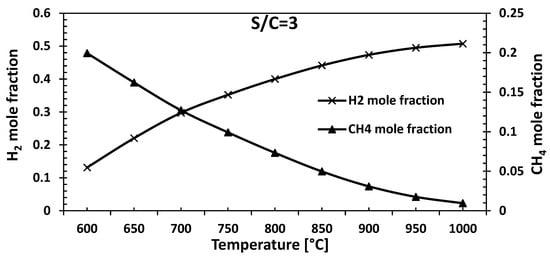
Figure 4.
CH4 and H2 mole fractions dependence on temperature.
Figure 5 and Figure 6 show the change in H2O, CO2, and CO mole fractions depending on temperature in the SMR process. At low temperatures of 600–700 °C, CO2 mole production increases. This is because CO is produced in the SMR system. The CO produced by the reaction is converted to CO2 by the water-gas shift (WGS) reaction, which is a side reaction. Since H2O is actively consumed in the reforming and WGS reactions, its consumption is high in this temperature range. At intermediate temperatures of 700–800 °C, the CO2 mole fraction reaches a maximum value of 0.055. At these temperatures, the WGS reaction can still be said to be working effectively. At temperatures above 800 °C, the CO2 mole fraction begins to decrease. This is because the equilibrium reaction shifts in the opposite direction at high temperatures. Since the WGS reaction is exothermic, CO2 production in the forward direction decreases at high temperatures. According to the data obtained, it is critical to maintain medium to high temperatures (700–900 °C range) for optimal hydrogen production in SMR. Still, at very high temperatures, WGS efficiency decreases due to the conversion of CO2 back to CO.

Figure 5.
H2O and CO2 mole fractions dependence on temperature.

Figure 6.
CO and CO2 mole fractions dependence on temperature.
The variation of CO2 mole fraction with temperature reflects the combined influence of two coupled equilibria: the endothermic steam methane reforming (CH4 + H2O ⇌ CO + 3H2) and the exothermic water–gas shift (CO + H2O ⇌ CO2 + H2). At low and intermediate temperatures (600–750 °C), the WGS reaction proceeds predominantly in the forward direction, converting CO into CO2 and increasing the CO2 mole fraction. However, as temperature rises above 800 °C, the exothermic WGS equilibrium shifts backward, reducing CO2 formation and increasing CO content, even though the SMR reaction continues to promote CH4 decomposition. Consequently, the CO2 profile increases and decreases with temperature, reflecting the thermodynamic interplay between the SMR and WGS reactions. This trend agrees with previous equilibrium analyses reported by Xu and Froment [] and Hou and Hughes [].
The effect of different steam/carbon (S/C) ratios at 900 °C on the hydrogen and methane mole fractions is clearly seen in Figure 7. The figure illustrates the variation of hydrogen production and methane conversion with increasing steam-to-carbon (S/C) ratios between 1 and 5 at 900 °C. As seen, the molar fraction of H2 starts around 0.52 (at S/C ≈ 1) and gradually declines to approximately 0.43 as the S/C ratio increases. This trend suggests that although a higher steam feed enhances methane reforming and facilitates greater CO and CO2 formation, the hydrogen content in the gas mixture becomes diluted. In other words, while the absolute amount of hydrogen produced rises, its relative concentration decreases due to the increased total gas volume. This observation supports the findings reported in the literature [], indicating that excessive steam supply raises the partial pressure of hydrogen in the reactor but simultaneously intensifies the dilution effect within the product stream.
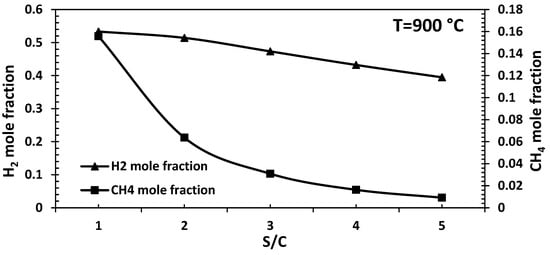
Figure 7.
Behavior of H2 and CH4 mole fractions according to the s/c ratio.
On the other hand, when the CH4 mole fraction is evaluated, the S/C ratio is approximately 0.15 at 1, but shows a rapid decrease as the ratio increases, falling below 0.01 at S/C ≈ 5. This trend enables the excess steam to support methane conversion, bringing it close to complete conversion. This finding explains why high S/C ratios are preferred in industry, particularly to minimize methane slip. The results show that at low S/C ratios (1–2), the hydrogen mole fraction is high but methane conversion is insufficient, leading to higher CH4 residues and partial conversion. In the medium S/C range (2–3), the hydrogen mole fraction rapidly decreases, while the CH4 mole fraction decreases significantly, providing optimal conversion conditions. At high S/C ratios (4–5), CH4 is almost completely converted, but the hydrogen mole fraction shows a limited decrease due to the dilution effect. These findings reveal that selecting the S/C ratio in the SMR process is critical. In industrial applications, the range S/C = 2.5–3.0 is generally preferred, as this range offers a balanced point regarding high conversion and optimum hydrogen yield. Additionally, while higher S/C values provide the advantage of extending catalyst life by preventing coke formation, they also increase energy consumption and reduce process efficiency.
Figure 8 illustrates the effect of the steam-to-carbon (S/C) ratio on the mole fractions of hydrogen and carbon dioxide at 900 °C. As the S/C ratio increases from 1 to 5, a significant rise in hydrogen production and a corresponding decline in CO2 formation are observed. At low S/C ratios (≈1), the H2 mole fraction is around 0.23, but it increases rapidly with higher steam content, reaching approximately 0.50 at S/C ≈ 3 and stabilizing near 0.53–0.55 at S/C ≈ 5. This increase results from enhanced methane reforming and water–gas shift reactions under steam-rich conditions.
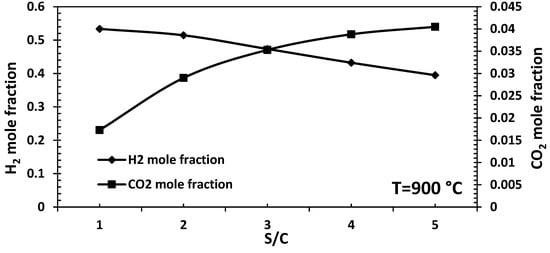
Figure 8.
Behavior of H2 and CO2 mole fractions according to the s/c ratio.
Conversely, the CO2 mole fraction starts relatively high (≈0.041) at low S/C ratios and gradually decreases to about 0.032 at S/C ≈ 5. This reduction can be attributed to the conversion of CO into H2 via the water–gas shift reaction and the dilution of CO2 in the expanded product gas. At low S/C ratios (1–2), hydrogen generation is limited, while CO2 concentration is higher. In the medium range (≈2–3), hydrogen formation increases rapidly as CO2 declines, indicating the optimal region for hydrogen yield. At high S/C ratios (4–5), hydrogen production reaches its maximum, but excessive steam addition increases energy demand and reduces the process’s overall efficiency.
Figure 9 shows the change in the molar fractions of syngas components as a function of catalyst mass (kg(cat)) at a temperature of 900 °C and S/C = 3. Upon examination of the graph, it can be seen that a rapid change in the molar fractions of the species occurs in the initial region of the reaction, followed by a steady approach to equilibrium and reaching constant values. The hydrogen mole fraction shows a sharp increase at the beginning of the reaction and stabilizes at approximately 0.45 after a short catalyst mass range. This situation indicates that the methane steam reforming reaction and the water-gas shift reaction occur rapidly and that hydrogen production is completed over short distances in the catalyst bed.

Figure 9.
Syngas Composition Profiles during Methane Steam Reforming: Influence of Catalyst Weight at S/C = 3 and 900 °C.
The molar fraction of methane is high at the start and decreases rapidly throughout the catalyst bed. As the catalyst mass increases, CH4 conversion is completed and stabilizes at low levels (≈0.01–0.02). This finding shows that methane conversion is effective at high temperatures and an S/C ratio of 3. The molar fraction of carbon monoxide is fixed at approximately 0.08–0.09. The incomplete consumption of CO indicates that the water–gas shift reaction cannot proceed completely in the forward direction due to reaction equilibrium limitations. In contrast, the molar fraction of carbon dioxide remains at low levels (~0.04–0.05), indicating that some of the CO is converted into CO2 but that the reaction has not reached full efficiency.
The molar fraction of water is initially high (≈0.35), shows a slight decrease throughout the catalyst mass, and reaches equilibrium at approximately 0.30. This result indicates that excess steam in the feed stream remains in the system after the reaction and that water is not entirely consumed, especially at high S/C ratios. In general, these results show that hydrogen is the dominant product in the system and is produced with high efficiency over short distances in the catalyst bed. Additionally, thanks to the high S/C ratio, methane conversion has been primarily achieved, coke formation has been prevented, and the system has reached a stable equilibrium. These findings support that an S/C ratio of approximately 2.5–3 in industrial SMR applications provides optimal conditions for high hydrogen production and catalyst stability.
Figure 10 shows the methane conversion depending on the catalyst mass for different steam/carbon (S/C) ratios at a temperature of 900 °C. At the start of the reaction, the conversion increases rapidly in areas where the catalyst mass is low, then the system approaches equilibrium and reaches constant values. Under S/C = 1 conditions, CH4 conversion remains at a maximum level of approximately 50%. This situation indicates that low steam feed limits the reaction kinetics, increases the risk of carbon deposition and thus prevents the complete conversion of methane. At S/C = 2, CH4 conversion is higher and stabilizes at approximately 70%. This condition indicates the optimum range commonly used in industrial applications. Moderate steam feed both increases methane conversion and suppresses carbon deposition. At S/C = 3, CH4 conversion reaches its maximum and stabilizes at approximately 80–82%. The high steam ratio supports methane conversion and increases hydrogen production. However, it is also known that in this case, energy consumption rises, process efficiency decreases, and some of the water remains in the system without being converted. Therefore, even though higher conversion rates are achieved, it may not always be the most economically efficient solution. These findings show that the S/C ratio is a critical parameter in methane conversion and that conversion is largely completed over short distances in the catalyst bed. Furthermore, it is again confirmed that the S/C ratio must be maintained in the range of 2–3 for optimum hydrogen yield and catalyst stability.
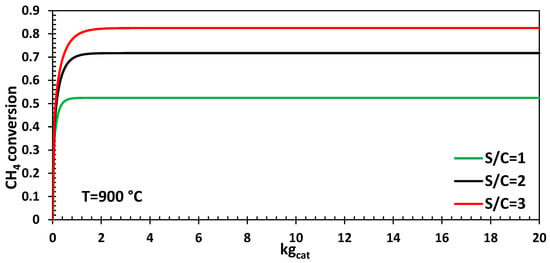
Figure 10.
Catalyst weight dependence of methane conversion at varying S/C ratios in steam methane reforming.
Figure 11 shows the greenhouse gas (GHG) emissions of conventional steam methane reforming (SMR) and steam methane reforming with carbon capture and storage integration (SMR + CCS) processes at different reformer temperatures under S/C = 3 conditions. The results provide essential comparisons regarding the environmental performance of hydrogen production methods. The conventional SMR process produces high specific greenhouse gas emissions across the entire temperature range (600–1000 °C). These values, which average 9–10 kgCO2/kgH2, clearly demonstrate the carbon intensity of fossil-based hydrogen production pathways. Although small fluctuations are observed as the temperature increases, the general trend shows that emissions remain stable at a high level. This situation demonstrates that even if more hydrogen is produced at high temperatures, CO2 formation is inevitable and therefore has a limited effect on reducing the carbon footprint.
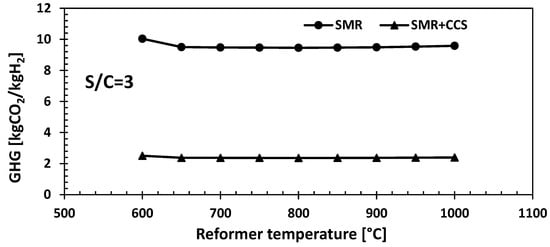
Figure 11.
CO2 emissions are dependent on reformer temperature in SMR and SMR + CCS systems.
In contrast, SMR + CCS integration dramatically reduces greenhouse gas emissions. Values across the entire temperature range are approximately 2.2–2.5 kgCO2/kgH2. This represents a reduction in emissions of more than 75% compared to conventional SMR. Thanks to the integration of CCS technology, a large portion of the CO2 released during the process is captured and removed from the system. This study also reveals that CCS is critical in moving hydrogen into the ‘blue hydrogen’ category. The results also show that the reformer temperature has a limited effect on greenhouse gas emissions under SMR + CCS conditions. This indicates that the performance of the carbon capture unit provides a constant emission reduction independent of the reformer conditions. Therefore, it can be said that the most critical factor in making the process climate-friendly is CCS integration rather than temperature optimization. Overall, the findings highlight the high carbon intensity of the conventional SMR process and the effectiveness of CCS integration in reducing emissions. These results support the need to transition to low-carbon solutions for hydrogen production and the strategic role that SMR + CCS can play as a transition technology.
Figure 12 shows the greenhouse gas emissions of traditional steam methane reforming (SMR) and carbon capture and storage integrated reforming (SMR + CCS) processes for different steam/carbon (S/C) ratios at a constant temperature of 900 °C. The findings reveal that the environmental impact of hydrogen production is directly related to the S/C ratio. When examining the conventional SMR process, it can be seen that emissions rise steadily as the S/C ratio increases. Emissions, which are approximately 7.5 kgCO2/kgH2 at S/C = 1, reach approximately 11.5–12 kgCO2/kgH2 at S/C = 5. This trend can be explained by the fact that high steam feed increases hydrogen production and energy consumption, leading to more CO2 formation through side reactions. Therefore, although high S/C ratios improve methane conversion in the SMR process, they also increase the environmental cost. Emission values for the SMR + CCS process are significantly lower. Under S/C = 1 conditions, greenhouse gas emissions are approximately 2.0 kgCO2/kgH2, rising to 3.0 kgCO2/kgH2 when S/C = 5. This demonstrates that CCS integration reduces emissions by 70–80% and maintains carbon intensity at low levels even under different S/C conditions. Similarly, the literature emphasizes that CCS integration is a critical solution for hydrogen to be classified as ‘blue hydrogen.’ The results also show that emissions in the SMR + CCS process increased to a limited extent depending on the S/C ratio. This demonstrates that the carbon capture unit operates at high efficiency and offers a significant environmental advantage regardless of changes in process parameters. Overall, the findings show that high conversion and efficiency are critical in hydrogen production and carbon management strategies. CCS integration significantly enhances the sustainability of SMR by maintaining emissions at low levels even with increasing S/C ratios.
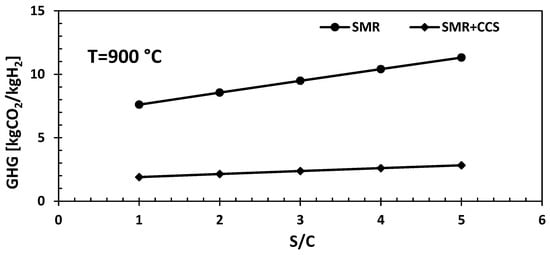
Figure 12.
GHG Intensity of Hydrogen Production via SMR and SMR + CCS at Different S/C Ratios.
Energy Penalty and Process Efficiency Impact of CCS
Although integrating CCS significantly reduces CO2 emissions, it also introduces additional energy requirements for solvent regeneration and CO2 compression. Based on Aspen HYSYS simulation results, the total regeneration heat duty for the 30 wt% MEA solvent was calculated as 3.4–3.6 MJ/kgCO2 captured, consistent with industrial post-combustion capture systems (3.0–4.0 MJ/kgCO2) [,]. When normalized to hydrogen output, this corresponds to an energy penalty of approximately 1.8–2.1 MJ/kgH2, resulting in an overall 6–8% reduction in process thermal efficiency compared with conventional SMR. Despite this drawback, CCS integration provides a net environmental benefit, reducing specific CO2 emissions from 9 to 12 kg CO2/kg H2(SMR) to 2–3 kg CO2/kgH2 (SMR + CCS). These results agree with the energy–emission trade-offs reported in earlier techno-economic and process integration studies [,]; Nessi et al., 2021 []) and highlight the importance of balancing carbon mitigation with system efficiency in blue hydrogen production.
4. Conclusions
This study presented a comprehensive numerical analysis of blue hydrogen production by integrating steam methane reforming (SMR) with carbon capture and storage (CCS) technologies. A MATLAB-based plug flow reactor (PFR) model for SMR kinetics and an Aspen HYSYS-based CCS model were combined to evaluate the effects of reformer temperature (600–1000 °C) and steam-to-carbon (S/C) ratio (1–5) on hydrogen yield and CO2 emission intensity.
The results demonstrated that hydrogen production efficiency increases significantly with temperature, reaching maximum conversion between 850 and 1000 °C. The optimal operating conditions were identified at S/C ratios of 2.5–3.0, which provide high hydrogen yield, reduced methane slip, and enhanced catalyst stability. Conventional SMR was found to produce between 9 and 12 kgCO2/kgH2, confirming its high carbon intensity. However, SMR + CCS integration reduced emissions to 2–3 kgCO2/kgH2, corresponding to more than 75% reduction. Importantly, CCS integration maintained stable emission levels regardless of reformer temperature and S/C variations, underlining its critical role in enabling low-carbon hydrogen production.
The findings highlight the environmental advantages of combining CCS with SMR, demonstrating its potential as a bridging technology in the transition toward sustainable and low-carbon energy systems. This study contributes novel insights into the quantitative relationship between process parameters and emission mitigation, providing valuable guidance for the future design and optimization of blue hydrogen production systems.
While the current framework accurately captures the thermochemical and environmental performance of SMR + CCS, it does not include detailed techno-economic evaluation, life-cycle assessment, or experimental validation of reactor kinetics. Future research should aim to (i) couple the existing model with process optimization and cost estimation modules, (ii) explore alternative low-energy solvents and membrane-assisted CO2 capture systems, and (iii) extend the modeling approach to autothermal reforming (ATR) and oxidative reforming configurations.
Overall, the results emphasize that blue hydrogen remains a promising transitional pathway toward carbon-neutral hydrogen production when integrated with efficient CCS systems. The developed modeling methodology offers a scalable foundation for future work that bridges kinetic modeling, process simulation, and sustainability assessment.
Author Contributions
Conceptualization, K.B. and T.B.; methodology, K.B. and T.B.; software, K.B.; validation, K.B. and T.B.; formal analysis, K.B.; investigation, K.B. and T.B.; resources, T.B.; data curation, K.B.; writing—original draft preparation, K.B. and T.B.; writing—review and editing, K.B. and T.B.; visualization, K.B. and T.B.; supervision, K.B.; project administration, K.B.; funding acquisition, K.B. All authors have read and agreed to the published version of the manuscript.
Funding
This research received no external funding.
Data Availability Statement
The original data presented in the study.
Conflicts of Interest
The authors declare no conflict of interest.
References
- Massarweh, O.; Al-khuzaei, M.; Al-Shafi, M.; Bicer, Y.; Abushaikha, A.S. Blue Hydrogen Production from Natural Gas Reservoirs: A Review of Application and Feasibility. J. CO2 Util. 2023, 70, 102438. [Google Scholar] [CrossRef]
- Ishaq, H.; Dincer, I.; Crawford, C. A Review on Hydrogen Production and Utilization: Challenges and Opportunities. Int. J. Hydrogen Energy 2022, 47, 26238–26264. [Google Scholar] [CrossRef]
- Staffell, I.; Scamman, D.; Velazquez Abad, A.; Balcombe, P.; Dodds, P.E.; Ekins, P.; Shah, N.; Ward, K.R. The Role of Hydrogen and Fuel Cells in the Global Energy System. Energy Environ. Sci. 2019, 12, 463–491. [Google Scholar] [CrossRef]
- Bayramoğlu, K. Energy and Exergy Analysis of Diesel-Hydrogen and Diesel-Ammonia Fuel Blends in Diesel Engine. J. Eta Marit. Sci. 2024, 12, 128–135. [Google Scholar] [CrossRef]
- Muhammed, N.S.; Gbadamosi, A.O.; Epelle, E.I.; Abdulrasheed, A.A.; Haq, B.; Patil, S.; Al-Shehri, D.; Kamal, M.S. Hydrogen Production, Transportation, Utilization, and Storage: Recent Advances towards Sustainable Energy. J. Energy Storage 2023, 73, 109207. [Google Scholar] [CrossRef]
- Bilgili, L. A Systematic Review on the Acceptance of Alternative Marine Fuels. Renew. Sustain. Energy Rev. 2023, 182, 113367. [Google Scholar] [CrossRef]
- Bayramoğlu, K.; Yılmaz, S.; Çoban, M.T. Numerical Analysis of Hydrogen Production by Methanol and Methane Steam Reforming Using Compact Reactors. Therm. Sci. Eng. Prog. 2025, 58, 103238. [Google Scholar] [CrossRef]
- Kumar, M.S.; Srinivasan, S.A.; Vichitra, M.; Amith, S.C.; Beemkumar, N.; Singh, R.P.; Kamakshi Priya, K. Green, Blue, and Turquoise Hydrogen: A Review of Production Technologies and Sustainability. Results Eng. 2025, 27, 106238. [Google Scholar] [CrossRef]
- Mokheimer, E.M.A.; Shakeel, M.R.; Harale, A.; Paglieri, S.; Ben Mansour, R. Fuel Reforming Processes for Hydrogen Production. Fuel 2024, 359, 130427. [Google Scholar] [CrossRef]
- Nakkeeran, K.; Victor, K. Grey and Blue Hydrogen: Insights into Production Technologies and Outlook on CO2-Free Alternatives. Sustain. Energy Technol. Assess. 2025, 75, 104222. [Google Scholar] [CrossRef]
- Bicer, Y.; Dincer, I. Life Cycle Environmental Impact Assessments and Comparisons of Alternative Fuels for Clean Vehicles. Resour. Conserv. Recycl. 2018, 132, 141–157. [Google Scholar] [CrossRef]
- Nnabuife, S.G.; Oko, E.; Kuang, B.; Bello, A.; Onwualu, A.P.; Oyagha, S.; Whidborne, J. The Prospects of Hydrogen in Achieving Net Zero Emissions by 2050: A Critical Review. Sustain. Chem. Clim. Action 2023, 2, 100024. [Google Scholar] [CrossRef]
- Budinis, S.; Krevor, S.; Mac Dowell, N.; Brandon, N.; Hawkes, A. An Assessment of CCS Costs, Barriers and Potential. Energy Strategy Rev. 2018, 22, 61–81. [Google Scholar] [CrossRef]
- IEAGHG. Comparison of Commercial, State-of-the-Art, Fossil-Based Hydrogen Production Technologies (DOE-NETL-2022/3241). In Communication from the Commission to the European Parliament, the Council, the European Economic and Social Committee and the Committee of the Regions; European Commission: Brussels, Belgium, 2017; Volume 53, p. 286. [Google Scholar]
- Zhong, H.; Wang, Z.; Zhang, Y.; Suo, S.; Hong, Y.; Wang, L.; Gan, Y. Gas Storage in Geological Formations: A Comparative Review on Carbon Dioxide and Hydrogen Storage. Mater. Today Sustain. 2024, 26, 100720. [Google Scholar] [CrossRef]
- Alizadeh, S.M.; Khalili, Y.; Ahmadi, M. Comprehensive Review of Carbon Capture and Storage Integration in Hydrogen Production: Opportunities, Challenges, and Future Perspectives. Energies 2024, 17, 5330. [Google Scholar] [CrossRef]
- Bayramoğlu, K. Application of Post-Combustion Carbon Capture Process in Marine Diesel Engine. Energy Sources Part A Recover. Util. Environ. Eff. 2023, 45, 10909–10925. [Google Scholar] [CrossRef]
- Peres, C.B.; Resende, P.M.R.; Nunes, L.J.R.; de Morais, L.C. Advances in Carbon Capture and Use (CCU) Technologies: A Comprehensive Review and CO2 Mitigation Potential Analysis. Clean Technol. 2022, 4, 1193–1207. [Google Scholar] [CrossRef]
- Usman, M.; Ghanem, A.S.; Garba, M.D.; Suliman, M.H.; Khan, S.; Khan, A.; Ahmed, U.; Humayun, M. Green and Blue Hydrogen Production and Purification Technologies. Int. J. Hydrogen Energy 2025, 153, 150176. [Google Scholar] [CrossRef]
- Pistidda, C. Solid-State Hydrogen Storage for a Decarbonized Society. Hydrogen 2021, 2, 428–443. [Google Scholar] [CrossRef]
- Diab, J.; Fulcheri, L.; Hessel, V.; Rohani, V.; Frenklach, M. Why Turquoise Hydrogen Will Be a Game Changer for the Energy Transition. Int. J. Hydrogen Energy 2022, 47, 25831–25848. [Google Scholar] [CrossRef]
- Curcio, E. Techno-Economic Analysis of Hydrogen Production: Costs, Policies, and Scalability in the Transition to Net-Zero. arXiv 2025, arXiv:2502.12211. [Google Scholar] [CrossRef]
- Oni, A.O.; Anaya, K.; Giwa, T.; Di Lullo, G.; Kumar, A. Comparative Assessment of Blue Hydrogen from Steam Methane Reforming, Autothermal Reforming, and Natural Gas Decomposition Technologies for Natural Gas-Producing Regions. Energy Convers. Manag. 2022, 254, 115245. [Google Scholar] [CrossRef]
- Ali Khan, M.H.; Daiyan, R.; Neal, P.; Haque, N.; MacGill, I.; Amal, R. A Framework for Assessing Economics of Blue Hydrogen Production from Steam Methane Reforming Using Carbon Capture Storage & Utilisation. Int. J. Hydrogen Energy 2021, 46, 22685–22706. [Google Scholar] [CrossRef]
- Katebah, M.; Al-Rawashdeh, M.; Linke, P. Analysis of Hydrogen Production Costs in Steam-Methane Reforming Considering Integration with Electrolysis and CO2 Capture. Clean. Eng. Technol. 2022, 10, 100552. [Google Scholar] [CrossRef]
- Özdeş, E.O.; Koç, Y.; Yağlı, H.; Köse, Ö.; Koç, A. Thermodynamic Analysis and Step-by-Step Performance and Emission Optimization of a Real Steam Methane Reforming (SMR) Hydrogen Production Plant. Int. J. Hydrogen Energy 2025, 140, 233–245. [Google Scholar] [CrossRef]
- Youcai, Z.; Ran, W. Chapter 1—Anaerobic Fermentation Process for Biomethane Production from Vegetable Waste. In Biomethane Production from Vegetable and Water Hyacinth Waste; Youcai, Z., Ran, W., Eds.; Elsevier: Amsterdam, The Netherlands, 2021; pp. 1–62. ISBN 978-0-12-821763-4. [Google Scholar]
- Bayramoğlu, K.; Özmen, G. Design and Performance Evaluation of Low-Speed Marine Diesel Engine Selective Catalytic Reduction System. Process Saf. Environ. Prot. 2021, 155, 184–196. [Google Scholar] [CrossRef]
- Zhang, S.; Wen, Z.; Liu, X.; Liu, X.; Wang, S.; Zhang, H. Experimental Study on the Permeability and Resistance Characteristics in the Packed Bed with the Multi-Size Irregular Particle Applied in the Sinter Vertical Waste Heat Recovery Technology. Powder Technol. 2021, 384, 304–312. [Google Scholar] [CrossRef]
- Bayramoğlu, K. Determination of Hydrogen Production Performance with Waste Exhaust Gas in Marine Diesel Engines. Int. J. Hydrogen Energy 2024, 52, 1319–1333. [Google Scholar] [CrossRef]
- Choi, H.; Kim, S.H.; Bae, J.; Katikaneni, S.P.R.; Jamal, A.; Harale, A.; Paglieri, S.N.; Lee, J.H. CFD Analysis and Scale up of a Baffled Membrane Reactor for Hydrogen Production by Steam Methane Reforming. Comput. Chem. Eng. 2022, 165, 107912. [Google Scholar] [CrossRef]
- Xu, J.; Froment, G.F. Methane Steam Reforming, Methanation and Water-gas Shift: I. Intrinsic Kinetics. AIChE J. 1989, 35, 88–96. [Google Scholar] [CrossRef]
- Hou, K.; Hughes, R. The Kinetics of Methane Steam Reforming over a Ni/a-Al2O Catalyst. Chem. Eng. J. 2001, 82, 311–328. [Google Scholar] [CrossRef]
- Numaguchi, T.; Kikuchi, K. Intrinsic Kinetics and Design Simulation in a Complex Reaction Network; Steam-Methane Reforming. Chem. Eng. Sci. 1988, 43, 2295–2301. [Google Scholar] [CrossRef]
- Wan, J.; Wang, H.; Gao, M. Reaction Using Fe2O3/γ-Al2O3 Catalyst. Catalysts 2023, 13, 114991. [Google Scholar]
- Linstrom, P.J.; Mallard, W.G. The NIST Chemistry WebBook: A Chemical Data Resource on the Internet. J. Chem. Eng. Data 2001, 46, 1059–1063. [Google Scholar] [CrossRef]
- Çengel Yunus, A. Book—Heat and Mass Transfer Fundamentals and Applications, 5th ed.; McGraw-Hill: New York, NY, USA, 2007; Volume 136, ISBN 9780073398181. [Google Scholar]
- Rossi, M.; Fanti, O.; Pacca, S.A.; Mancinelli, E.; Comodi, G. E-REFORMER for Sustainable Hydrogen Production: Enhancing Efficiency in the Steam Methane Reforming Process. Appl. Energy 2025, 401, 126625. [Google Scholar] [CrossRef]
- Bayramoğlu, K.; Bayraktar, M.; Seyhan, A.; Yuksel, O. Evaluation of Techniques to Reduce Carbon Emissions from Ships within the Scope of Revised Greenhouse Gas Emission Targets for 2030, 2040, and 2050. Ocean Eng. 2025, 334, 121605. [Google Scholar] [CrossRef]
- Hosseinifard, F.; Aghdami, G.; Salimi, M.; Amidpour, M. Thermo-Economic Feasibility of Heliostat and Parabolic Trough Collector Integration with Optimized Configuration of Post-Combustion Carbon Capture for Steam Methane Reforming. Fuel Process. Technol. 2025, 271, 108207. [Google Scholar] [CrossRef]
- Nessi, E.; Papadopoulos, A.I.; Seferlis, P. A Review of Research Facilities, Pilot and Commercial Plants for Solvent-Based Post-Combustion CO2 Capture: Packed Bed, Phase-Change and Rotating Processes. Int. J. Greenh. Gas Control 2021, 111, 103474. [Google Scholar] [CrossRef]
- Haider, J.; Lee, B.; Choe, C.; Abdul Qyyum, M.; Shiung Lam, S.; Lim, H. SNG Production with Net Zero Outflow of CO2 in an Integrated Energy System: An Energy and Economic Aspects. Energy Convers. Manag. 2022, 270, 116167. [Google Scholar] [CrossRef]
- Abawalo, M.; Pikoń, K.; Landrat, M. Comparative Life Cycle Assessment of Hydrogen Production via Biogas Reforming and Agricultural Residue Gasification. Appl. Sci. 2025, 15, 5029. [Google Scholar] [CrossRef]
Disclaimer/Publisher’s Note: The statements, opinions and data contained in all publications are solely those of the individual author(s) and contributor(s) and not of MDPI and/or the editor(s). MDPI and/or the editor(s) disclaim responsibility for any injury to people or property resulting from any ideas, methods, instructions or products referred to in the content. |
© 2025 by the authors. Licensee MDPI, Basel, Switzerland. This article is an open access article distributed under the terms and conditions of the Creative Commons Attribution (CC BY) license (https://creativecommons.org/licenses/by/4.0/).